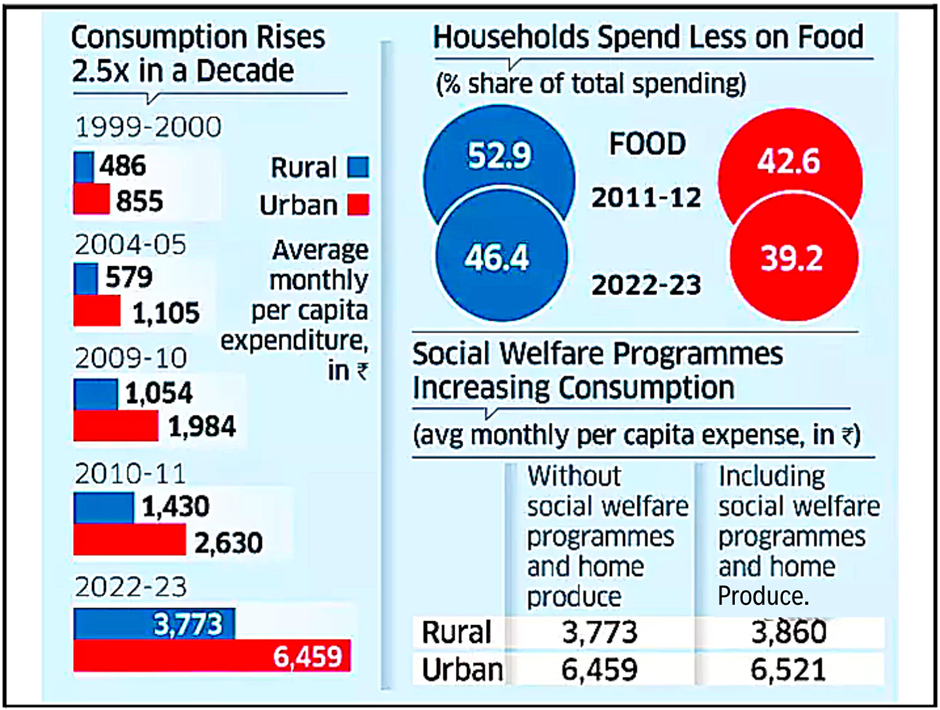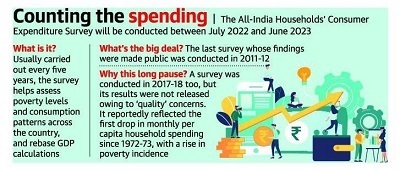Context:
The National Sample Survey Office (NSSO), Ministry of Statistics and Programme Implementation has conducted Household Consumption Expenditure Survey (HCES) during August 2022 to July 2023 which aims at generating estimates of household Monthly Per Capita Consumption Expenditure (MPCE) and its distribution separately for the rural and urban sectors of the country, for States and Union Territories, and for different socio-economic groups.
Public Distribution System (PDS)
The Public Distribution System (PDS) is a vital social security program in India, aimed at ensuring food security. Under the National Food Security Act (NFSA), 2013, up to 75% of the rural population and 50% of the urban population are eligible for subsidised foodgrains. Subsidising foodgrain costs frees up household resources for other essential items such as vegetables, milk, pulses, eggs, fish, meat, and other nutrient-rich foods. The release of data from the Household Consumption Expenditure Survey (HCES):2022-23 will renew interest in understanding the impact of free PDS food on non- foodgrain expenditure.

Household Consumption Expenditure Survey (HCES)
Survey Representativeness and Data Collection
The HCES:2022-23 collected information on food and non-food items received free of cost through various social welfare programs. The National Sample Survey Office (NSSO) report provides detailed information and aims to examine the characteristics of households receiving benefits rather than providing precise estimates of the proportion of households under every scheme. Researchers compare the proportion of households consuming PDS items with NFSA coverage to address inclusion and exclusion errors. Detailed information on ailments, fee waivers, or reimbursements in health and education is not possible without specific data, which the NSSO collects through separate surveys.
Imputation of Values in the Survey
To assist analysts and researchers, the NSSO has, for the first time, imputed the value of selected food and non-food items received free. This enables the computation of two metrics: Monthly Per Capita Consumption Expenditure (MPCE) and the value of household consumption considering the imputed value of free items ('MPCE with imputation'). The NSSO suggests two sets of values for each state and sector (rural, urban) for imputing free items: modal unit price and the 25th percentile unit price. The imputed value focuses on items received free, not those purchased from the PDS at subsidized prices.
Findings from the Survey Data
The main item received free by households was PDS foodgrains. At the national level, about 94% in rural and 95% in urban areas of the imputed item value is attributable to food. For all households, the imputed value for food is ₹82 and ₹59 in rural and urban areas, respectively. The NSSO report shows the average MPCE among different fractile classes, revealing that 20% of those in the bottom 5% of the rural distribution are actually in the next fractile class (5%-10%). This pattern is observed until the sixth fractile class. Urban areas also show upward movement. Researchers can use the modal value for PDS purchases at subsidized rates, increasing the average MPCE with imputation. Limited imputation exercises indicate that in-kind social transfers significantly increase the consumption value of poorer households.
Implications for Poverty and Well-being
The release of the report has sparked discussions on where to draw the poverty line. It raises questions about whether to estimate the number of poor households based on expenditure or the total value of consumption, including free items. In-kind social transfers have significant implications for the well-being of households at the bottom end of the consumption or income distribution.
- Redefining the Poverty Line : Traditionally, poverty lines in India have been based solely on household expenditure. The HCES data, with its imputed value for free PDS foodgrains, challenges this approach. It raises the question of whether the poverty line should be based on total consumption value, including in-kind transfers like subsidized food. This could potentially lead to a revision of the poverty line, potentially reducing the number of people classified as poor if the value of free food is significant.
- Improved Well-being for Low-Income Households : The survey data suggests that in-kind transfers through PDS significantly increase the consumption value of poorer households. The imputed value of PDS foodgrains is highest for the lowest expenditure groups, indicating a crucial safety net for those struggling to afford essential food items. This subsidized food frees up household resources for other necessities, potentially leading to improved dietary diversity and overall well-being.
- Targeting and Efficiency : The HCES data can be used to assess the effectiveness of PDS in reaching its intended beneficiaries. By analyzing the characteristics of households receiving PDS benefits, policymakers can identify potential gaps or areas for improvement in targeting. This could involve tightening eligibility criteria for exploring alternative distribution channels to ensure PDS benefits reach the most vulnerable populations.
- Impact on Other Social Programs : The HCES data provides a holistic picture of household consumption, including both expenditure and in-kind transfers. This allows for a more comprehensive evaluation of the impact of various social welfare programs on poverty reduction and well-being. Analyzing how PDS interacts with other programs, like subsidized fuel or healthcare schemes, can help policymakers create a more integrated social safety net for the most vulnerable.
Conclusion
The Household Consumption Expenditure Survey Data provides valuable insights into the impact of social transfers on household expenditure. By analyzing the imputed values of free items, researchers can better understand how PDS and other social welfare programs contribute to improving the consumption value and well-being of poorer households in India.
|
Probable Questions for UPSC Mains
|
Source: The Hindu







